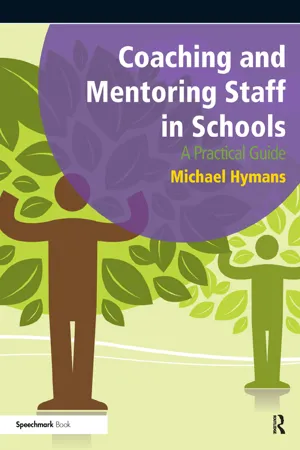Chapter 1: Defining Coaching and Mentoring: Similarities and Differences
The approach taken in this chapter is along the lines of proposing that there cannot be a definitive answer to the question of differences between coaching and mentoring as the two terms seem to be increasingly linked and are often used interchangeably. The definitions used are as follows:
• A coach sets specific goals and objectives, sees what the other person needs to do to achieve them and works with that person on target setting, professional and personal development and expansion of skills, offering practical and relevant advice and guidance (examples of practical goals and objectives are provided with case studies showing how these can be used for individual staff personal and professional development).
• A mentor can be seen as a wise, experienced friend-type person who leads by example and acts as a role-model. They will be very good at helping the other person see the big picture and have an understanding of the politics of the school to make it work for the other person (examples of staff mentoring are provided).
A coach can be a mentor and a mentor can be a coach, or the role can be rolled into one. The key for readers is that whatever term they use, the person being coached or mentored gets unbiased support and guidance. The Chartered Institute of Personnel Development (CIPD, 2007) lists some characteristics of coaching in organisations that are generally agreed upon by most coaching professionals:
• It consists of one-to-one developmental discussions.
• It provides people with feedback on both their strengths and weaknesses.
• It is aimed at specific areas.
• It is essentially a non-directive form of development.
• It focuses on improving performance, developing and enhancing individuals’ skills and is used to address a wide range of issues.
• Coaching activities have both organisational and individual goals.
• It works on the premise that coachees are self-aware, or can achieve self-awareness, and while personal issues may be discussed, the emphasis is on performance at work.
• It is a time-bounded and skilled activity.
Differences Between Mentoring and Coaching
The CIPD differentiates between coaching and mentoring. It is helpful to understand these differences. Although many of the processes are similar, they are generally delivered by individuals with different qualifications and different relationships with their client.
| Mentoring | Coaching |
| Ongoing relationship that can last for a long period of time. | Relationship generally has a set duration. |
| Can be more informal and meetings can take place as and when the mentee needs some advice, guidance or support. | Generally more structured in nature and meetings are scheduled on a regular basis. |
| More long-term and takes a broader view of the person. | Short-term (sometimes time-bounded) and focused on specific development areas/ issues. |
| Mentor is usually more experienced and qualified than the ‘mentee’. Often a senior person in the organisation who can pass on knowledge, experience and open doors to otherwise out-of-reach opportunities. | Coaching is generally not performed on the basis that the coach needs to have direct experience of their client’s formal occupational role, unless the coaching is specific and skills-focused. |
| Focus is on career and personal development. | Focus is generally on development/issues at work. |
| Agenda is set by the mentee, with the mentor providing support and guidance to prepare them for future roles. | The agenda is focused on achieving specific, immediate goals. |
| Mentoring revolves more around developing the mentee professionally. | Coaching revolves more around specific development areas and issues. |
Hahn (2008) says that it is easy to become confused about the differences between coaching and mentoring. Quite often the two terms are used interchangeably when in fact there are some very specific distinctions. The primary distinction between the two is ‘who established the course of action’. In mentoring, the course of action is usually provided by the mentor, whereas in a true coaching engagement, it is the coachee who creates the action plan. Hahn (2008) suggests that most leaders revert to mentoring, thinking they are coaching and as a result the lasting quality of the session is marginalised. The reason is that if a person sets a personal goal, and successfully accomplishes it after painstakingly working toward its achievement, personal and professional growth is always a powerful by-product. The result is that similar situations will seem familiar, the coachee’s confidence will rise and they can approach that new problem with greater confidence. In a mentoring engagement, however, the mentee does not go through the pain of evaluating options, choosing a course of action or experiencing the personal satisfaction of conquering the challenge. Thus, they are deprived of a key component of coaching which is personal and professional growth.
In mentoring, the mentor generally provides an expeditious solution and recommends a course of action. In coaching, it is the coachee who generates the solution. The coach merely helps them to uncover their goals and align a strategy. The coach then provides encouragement and accountability to help the coachee attain their goals. The primary objective in coaching is to expand the coachee’s comfort zone. The coach is a catalyst in affecting lasting personal growth, balance and contentment. Implied in this process is that it is the coachee, not the coach, who arrives at alternatives, seeks a solution and charts the corrective course.
The coach’s responsibility is to offer perspective through powerful questions then motivate and hold the coachee accountable to attaining their objectives. In fact, mentoring is often a smaller component of a coaching engagement. An example is enabling the person you are coaching to effectively utilise their personal traits and skills in the context of the school. The coach acts as a mentor when they apply their experiences to clarify a specific question pertaining to the coachee’s role in school or clarify the relationship of that coachee to their professional role. For example, does the coachee have:
• a clear understanding of his or her role in school
• clearly defined tasks/responsibilities
• a well-defined career path and understand their career interests
• a good understanding of the culture and norms of the school?
Coachees and Mentees: What do they Understand?
As a facilitator of school-based coaching or mentoring programmes for staff, ask a group of staff to work in pairs to answer the questions above. Ask the pairs to share their answers in groups of six to eight and then take feedback from these groups. The information collected could be taken to a senior leadership team (SLT) meeting for discussion about developing a whole-school action plan to address any outstanding issues.
Similarities between Coaching and Mentoring
It is not unusual to change hats from coach to mentor, sometimes within a single session. As this happens, both the coach and coachee must be aware of this shift and acknowledge the difference. However, coaching and mentoring are processes that enable both the individual and groups to achieve their full potential. Coaching and mentoring share many similarities so it makes sense to outline the common things coaches and mentors do:
• Facilitate the exploration of needs, motivations, desires, skills and thought processes to assist the individual in making real, lasting change.
• Use questioning techniques to facilitate thought processes in order to identify solutions and actions rather than take a wholly directive approach.
• Support the setting of appropriate goals and methods of assessing progress in relation to these goals.
• Encourage a commitment to action and the development of lasting personal growth and change.
• Maintain unconditional positive regard for the coachee or mentee, which means that the coach or mentor is at all times supportive and non-judgemental of the coachee or mentee, their views, lifestyle and aspirations.
• Ensure the development of personal competencies and avoid unhealthy dependencies on the coaching or mentoring relationship.
• Evaluate the outcomes of the process, using objective measures wherever possible to ensure the relationship is successful in the achievement of personal goals.
Mentoring
Rolfe (2006) describes the mentoring philosophy as one in which mentoring is seen as a gift that is shared. It is a relationship that enables purposeful conversation. The conversation assists the mentee to reflect on their own experience, make informed decisions and act upon the ideas that are generated. The purpose of mentoring is development. It is about learning not teaching and both mentors and those mentored grow from the experience.
In mentoring, people develop a synergetic relationship through a conversation that enables them to set and achieve goals, make decisions and solve problems. Any person who has the skill to facilitate the mentoring process may be a mentor. Mentoring is enriching and satisfying for both partners. The role of the mentor is to build rapport, ask questions, listen and elicit the mentee’s own wisdom. The mentor does not have to be older, wiser or have specialised knowledge in any field. They need to be skilled in leading a mentoring conversation.
The mentoring conversation invites the mentee to reflect on their own experience with a situation, issue or problem, then gather information from a variety of sources (perhaps including the mentor), sort through options and decide on a course of...

